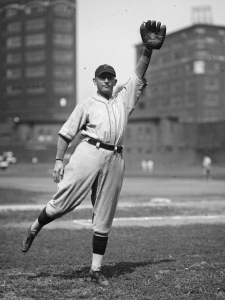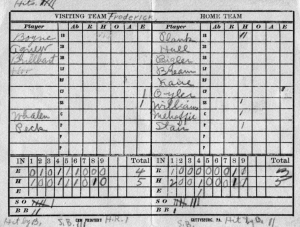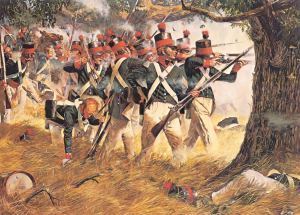James Rada Jr.'s Blog, page 24
January 13, 2015
Get “Canawlers” for $1.99 for a limited time!
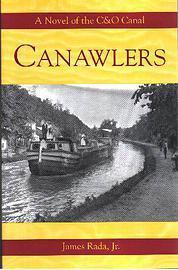 At a time of war, the Chesapeake and Ohio Canal was caught in the crossfire between two nations.
At a time of war, the Chesapeake and Ohio Canal was caught in the crossfire between two nations.
Hugh Fitzgerald proudly calls himself a “canawler.” He works on the C&O Canal transporting coal nearly 185 miles between Cumberland, Maryland, and Georgetown. For nine months a year, he and his family live on their canal boat, working hard to get them through the lean winter months.
The year 1862 was a hard year to live on the canal, though. The Civil War was in full swing and the canal, which runs along the Potomac River, marked the border between the Union and Confederacy. To this point, the Confederacy has stayed south of the canal, but now the Confederate Army intends to go on the offensive and take the war into the north.
Not only are the Fitzgeralds’ lives endangered by the increased activity of warring armies and raiders on the canal, but the Fitzgeralds’ secret activity as a stop along the Underground Railroad only endangers their lives all the more.
Then fate takes Hugh away from his family, leaving his wife, Alice, to hold the family together. With the help of her children; Thomas, George and Elizabeth; Tony, an orphan from Cumberland; and David Windover, a disillusioned Confederate soldier, they will face the dangers presented by the war, nature, and the railroad together.
Midwest Book Review called this book, “A powerful, thoughtful and fascinating historical novel, Canawlers documents author James Rada, Jr. as a writer of considerable and deftly expressed storytelling talent.”
Now you can get the Kindle version of Canawlers for limited time for just $1.99. It will introduce you to Fitzgerald family who featured in three novels and a novella about the canal during the Civil War.

January 6, 2015
Don���t let the flu get you!
 ��So it seems like everyone lately has the flu. Schools are sending warnings home to parents. Hospitals are telling patients with the flu not to come in. The Centers for Disease Control has said that is has hit epidemic level.
��So it seems like everyone lately has the flu. Schools are sending warnings home to parents. Hospitals are telling patients with the flu not to come in. The Centers for Disease Control has said that is has hit epidemic level.
So how bad can it get?
The worst to date has been the Spanish Flu pandemic of 1918. It left about 50 million dead after just a couple months. I wrote about it in my novel October Mourning. I’ve also written about half a dozen articles about it and given a couple talks about it.I continue to be fascinated (scared?) by it.
It killed more people than World War I and in a shorter time frame, too, yet the war had the headlines during 1918. It was estimated that 675,000 Americans died from the Spanish Flu or 10 times more than died in the war.
It killed more people in one year than the Black Plague did in 4 years.
It was so devastating that human life span was reduced by 10 years in 1918.
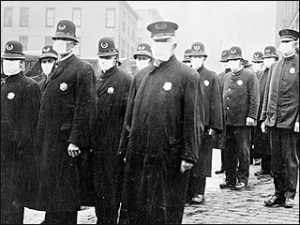 Here���s how it was described. One physician wrote that patients rapidly ���develop the most vicious type of pneumonia that has ever been seen��� and later when cyanosis appeared in patients ���it is simply a struggle for air until they suffocate.��� Another doctor said that the influenza patients ���died struggling to clear their airways of a blood-tinged froth that sometimes gushed from their mouth and nose.���
Here���s how it was described. One physician wrote that patients rapidly ���develop the most vicious type of pneumonia that has ever been seen��� and later when cyanosis appeared in patients ���it is simply a struggle for air until they suffocate.��� Another doctor said that the influenza patients ���died struggling to clear their airways of a blood-tinged froth that sometimes gushed from their mouth and nose.���
Public meetings were cancelled. Street cars and other public transportation had to travel with windows open. Plus, you couldn���t spit on the street and needed to use a handkerchief when you cough or sneeze or face a fine in many places.
It wasn���t that the flu was particularly deadly. It was about 10 times deadlier than the average flu, or rather, it had a 2.5 percent mortality rate according to one report I read. While deadly for flu, there are diseases with a much-higher mortality rate. The thing about those diseases is that they usually aren���t that contagious. I���ve read that the Spanish Flu struck half of the world���s population.
So turn it into a math problem.
A disease like ebola kills about 50 percent of those who get it, but there were only something like 21,000 cases last year. So the chances of you catching ebola, much less dying from it were unlikely.
However, Spanish Flu killed 2.5 percent of those who got it and you had a 50 percent chance of catching it. That means 15 out of every 1000 people in the world, regardless of whether they caught the flu or not, died.
Doctors and nurses, who were exposed more frequently to sick patients, caught the flu. Many died, leaving a heavier burden on those behind. They found themselves at even a greater risk of exposure.
Medical personnel weren���t the only ones affected. Trains struggled to run on time because of sick personnel. Few operators meant that fewer calls were getting through.
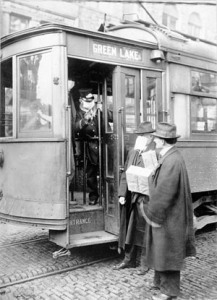 Undertakers couldn���t keep up with the demand for new graves. Yet, in many places the ground was frozen so the bodies had to be stored in piles in some towns.
Undertakers couldn���t keep up with the demand for new graves. Yet, in many places the ground was frozen so the bodies had to be stored in piles in some towns.
Then the flu season ended and fewer cases were reported. There was a bit of a resurgence in early 1919, but the flu had already started mutating. The new form wasn���t as contagious, and by the fall, the flu was back to being just something that kept people home from work or school for a few days.

January 2, 2015
Inspired: How Washington County (Md.) set Laura Hillenbrand on the track to bestsellerdom
As a young girl, bestselling-author Laura Hillenbrand and her older sister, Susan, rode horses over the Washington County hills and along the Chesapeake and Ohio Canal towpath. They rode bareback, sliding back and forth and trying to stay astride the horse while only holding onto bridles they���d made from twine.
���We did a lot of riding and a lot of falling off,��� Hillenbrand said. When they did fall off, they had to protect their heads since they didn���t wear helmets. It might have been a little dangerous, but it was a lot of fun.
Hillenbrand and her family spent much of the summers of her youth at their farm in Sharpsburg. Her father worked as a lobbyist in Washington, D.C. and the 600-acre farm served as a getaway and refuge from the stress of the city. The stone farm house where they lived had served as a field hospital after the Battle of Antietam.
With not a lot of choices for fun activities to do during the long summer days, Hillenbrand would wander the property following trails through the woods and occasionally finding a relic. ���I became completely fascinated by the Civil War,��� she said. ���We would sometimes find artifacts. We found bullets and even a general���s belt buckle.���
She and her sister would also save up their babysitting money and buy bus tickets to the Charles Town Race Track across the Potomac River from Sharpsburg to watch thoroughbred horse racing.
���I loved the ride over there. I fell in love with racing history and talking to those old people on the Greyhound bus who had been going to the races for years,��� Hillenbrand said.
That Western Maryland farm sparked two great passions in Hillenbrand���s adult professional life ��� history and horse racing. She grew up to become a New York Times bestselling author who makes history accessible and interesting to general audiences.
���A lot of textbooks aren���t well written,��� Hillenbrand said. ���The people who wrote them didn���t understand that these are stories. You can tell them like you would a novel. You just have to stick to all the facts and do your research.���
The result of Hillenbrand���s research and writing was Seabiscuit: An American Legend. The race horse was the biggest news maker of 1938, which is also the same year he beat out Triple Crown Winner Man O���War to be named the U.S. Horse of the Year. Most of the people who are associated with Seabiscuit are now dead and little seems to have remained about his story except for yellowed newspapers and out-of-print books. Hillenbrand owned one such book. Come On Seabiscuit was a 1963 children���s book that she bought for a quarter at a book fair in Bethesda when she was eight years old.
���I read the cover right off that book and I still have it,��� Hillenbrand said.
As with most children���s books, though, it had little in the way of text.
���I knew there was a big untold story there,��� she says.
So Hillenbrand set out to tell it. It took her five years to write Seabiscuit, but the hard work paid off. The book has sold 6 million hardcover and paperback copies in print and won the William Hill Sports Book of the Year in 2001. It was also made into an Academy-Award-nominated film in 2003. She said seeing her book made into a movie was ���surreal.���
���I never get used to it,��� she says. ���I���ll remember writing a scene and then to see that on the screen is the weirdest thing.���
Though Hillenbrand was born in Fairfax, Va., she grew up in Montgomery County. She lived across the street from Bethesda Elementary and is a graduate of Bethesda-Chevy Chase High School.
���Everything has changed so much when I go there, I don���t recognize it anymore. It so much more crowded,��� she said.
As a pre-teen, Hillenbrand remembers getting into trouble for not doing her homework at Leland Jr. High School because she was more interested in writing her own stories.
���I knew what I did [when I grew up] would involve writing and history. Part of my love of history comes from my Dad���s farm being saturated in history,��� she said.
Hillenbrand���s latest book is called Unbroken: A World War II Story of Survival, Resilience, and Redemption. It���s the story of Louis Zamperini who was considered one of the fastest men alive in the late 1930���s and has an inspiring story of the survival after being shot down during WWII and of enduring inhumane treatment as a Japanese prisoner of war.
Hillenbrand discovered his story while poring over newspapers from the 1930s for her research for Seabiscuit.
���I turned over the page of an article I was reading about Seabiscuit and saw this article about a kid who was setting the world on fire,��� Hillenbrand says.
It caught her attention and as she learned more about Zamperini, she became fascinated by his story.
���I���d never heard a true story like that,��� Hillenbrand says. ���I knew I had to write the book to know how a guy can get to the point where [Zamperini] can forgive what he had to forgive.���
Though Hillenbrand and her husband now live in northwest Washington, D.C., she still enjoys Maryland.
���I love Maryland,��� Hillenbrand said. ���I used to spend my weekends going to the race track and going to the beach. I love how Maryland has mountains and quiet woods on one end and the ocean on the other end.���
��This is an article that I wrote that originally ran in 2012 in Maryland Life Magazine.

December 28, 2014
Why “Unbroken” the book is better than the movie
My wife and I went to see Unbroken last night. I loved the book and was very excited to see the movie, but it didn���t live up to the book. As my wife pointed out, ���The book is always better.���
But why is that? The movie was well acted and the effects looked good. So I was trying to think about why it left me disappointed.
Part of it was definitely because a lot needed to be cut from the book. The movie focuses on Louis Zamperini���s prison-camp experiences. It certainly is the most-exciting part of the book when Zamperini is facing life-or-death consequences.
It only gives his running career and change from petty thief to Olympic champion a partial look and pretty much ignores his battle and recovery from post-traumatic stress. By giving those two sections of his life short shift, it ignored significant parts of what made Zamperini such an interesting person.
His running childhood and running career showed readers how he developed such a strong belief in ���If you can take it, you can make it.��� The movie made his rise to fame as an Olympic runner look fairly simple. It wasn���t.
Also, while the WWII experiences showed how Louis remained unbroken physically and mentally, the last part showed why he was unbroken spiritually. This was perhaps the most-important part of the story.
Running came easy to him. He worked hard at it, but his life wasn���t on the line only his pride. His WWII experiences were a greater challenge to him and nearly broke him at times, but he hung on. However, I would say that his post-traumatic stress did break him. He became an alcoholic.
That is not to say that he didn���t put his life back together. With help, he repaired himself and learned how to move forward. This might not have been exciting to see on the screen, but it was important for the man.
Go see the movie. It���s definitely worth it, but when you finished watching the movie, do yourself a favor and read the book by Laura Hillenbrand. As my wife says, ���The book is always better than the movie.���

December 18, 2014
Frederick baseball showed some hustle in the Blue Ridge League
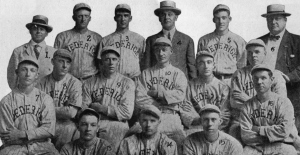 �� �� �� �� �� On Thursday morning, May 27, 1915, H.A. Albaugh showed his love of baseball in two ways. He drove 42 miles over stone and hard-packed dirt roads from his home in Westminster to Frederick in order to see the Frederick Hustlers make their professional baseball debut. The drive took him about two hours and before leaving home, he made a bet with a friend that Frederick would win its opening day game. If the Hustlers lost, Albaugh promised that he would walk home.
�� �� �� �� �� On Thursday morning, May 27, 1915, H.A. Albaugh showed his love of baseball in two ways. He drove 42 miles over stone and hard-packed dirt roads from his home in Westminster to Frederick in order to see the Frederick Hustlers make their professional baseball debut. The drive took him about two hours and before leaving home, he made a bet with a friend that Frederick would win its opening day game. If the Hustlers lost, Albaugh promised that he would walk home.
It was a daring bet. The Hustlers were playing the Martinsburg Champs who had been the league champs in the defunct Tri-City League the previous year. Albaugh and Frederick City had chosen their champion, though, and the Hustlers didn’t disappoint.
Professional Baseball Comes to Frederick
���������������������� Though baseball came to Frederick County near the beginning of the 20th Century, it wasn���t played professionally in the county until 1915. Until that time, you could watch town teams compete against each other.
The semi-pro Sunset League formed in 1907 and included a team from Frederick City. The league, which was named because its games were played from late afternoon until sunset, folded in 1911. Then in 1914, the Frederick Hustlers became part of the Tri-City League with Hagerstown and Martinsburg, W.Va.
As the season was winding down, Charles Boyer, a former president of the South Atlantic League, moved back to the Hagerstown area. He watched the town teams playing each other and saw that there was talent among the players that deserved to be rewarded.
He purchased the Hagerstown team and set to work forming a new baseball league that would soon be named the Blue Ridge League. Boyer wanted the league to be a professional league, which meant that it needed a minimum of six teams.
���The Frederick team had been called the Black Sox in the Tri-City League, but as the Blue Ridge League started, they had a very fast team so they became the Hustlers,��� says Mark Ziegler who runs the web site BlueRidgeLeague.org.
Boyer started with the three teams of the Tri-City League and was able to convince Chambersburg and Gettysburg in Pennsylvania to field teams. While the league certainly had enough teams to play the 1915 season, it was short the needed number to petition the National Commission (now the National Association of Professional Baseball Leagues) for professional status.
Then in March of 1915, Hanover joined the league and the Blue Ridge League was granted Class D recognition ��� the lowest class of professional status in baseball.
���It was entry level baseball,��� says Robert Savitt, author of The Blue Ridge League and a Myersville resident. ���Even though the players got paid, they still needed to have other jobs.���
As the teams set about recruiting players, they had little to offer despite the fact they were professional teams. Frederick lost the chance of having Ty Cobb���s younger brother play for the Hustlers because the team had already reached its $500 a month salary cap, according to the Frederick Post.
Opening Day
���������������������� With the introduction of professional baseball to the region, towns caught baseball fever.
“Not a thing has been left undone to make the big day of the advent of Frederick into organized baseball one long to be remembered…” the Frederick Post reported on May 27, 1915, opening day for the season and the league.
The Frederick mayor and aldermen had declared the day a half holiday with most businesses closing their doors in the afternoon so that both employees and customers could go out to Agricultural Field to watch the Hustlers play the Martinsburg Champs. While the Hustlers were the hometown favorites, the Champs had won the 1914 pennant in the Tri-City League.
The events of the day kicked off with a parade at 1:30 p.m. A marching band struck up ���It���s a Long Way to Tipperary��� and started down Patrick Street. The band was followed by Frederick Police Chief George Hoffman riding a horse and most the Frederick Police force. The parade continued with 20 cars and six carriages carrying the players and other officials, including Mayor Lewis Fraley, Alderman Lloyd Culler and Alderman Henry Abbott.
The parade proceeded to the cemetery and then traveled to the fountain on North Market Street, down Market Street to the town square and out to Agricultural Park. The Fairgrounds Board had built the field in 1903 at the southwest corner of the fairgrounds.
An estimated 3,000 fans turned out to see the 3:30 p.m. game. Frederick won with a final score of 14-3.
“The game was a slaughter from the time Frederick began scoring in the second round until the last Martinsburg player was out in the ninth and by the time the sixth had arrived the fans had lost interest,” reported the Frederick Post.
It seemed that the Hustlers were on fire. From the opening day victory, they went on to win 17 of their first 20 games of the season.
Playing the Big Boys
As the season progressed, the Hustlers looked like they were unstoppable. However, on August 31, 1915, they were stopped quickly decisively. The new professional baseball league had caught the attention of major league coaches like Jack Dunn and Connie Mack. They were on the lookout for new talent.
Mack had already stolen away one of the Hustlers named Lew ���Cy��� Malone.
���Cy Malone was an infielder for the Hustlers before Mack took him up to the majors,��� says Ziegler.
On August 31, Malone, Mack and the Athletics came to Frederick to play the Hustlers. Turnout at Agricultural Field was back to its opening day level.
Frederick took an early lead in the game, but ���A fusillade of extra-base hits in the ninth inning of yesterday���s great game at Agricultural Park, enabled the Philadelphia Athletics to carry off a victory,��� according to the Frederick Daily News. The final score was 7-3.
The newspaper noted that Malone played well and ���looked like a big leaguer from every angle.���
Champions
By mid-August, the Hustlers had clinched the first pennant for the Blue Ridge League with six scheduled games left.
���They have obtained such a lead in the last month that it will not be necessary to play off the several postponed and tie games,��� the Frederick Daily News Reported.
The Hustlers finished the season with a record of 53-23-1. The team also finished the season with the top hitter and pitcher in the league. Bobbie Orrison from Brunswick was an outfielder with a .341 batting average. Bill King of Jefferson was the pitcher with 17 wins.
It had also been a financially successful season. The Frederick Post noted the following year that, ���The fans were joyous, we had a winning club, the pitchers and the best hitter was also a member of the Hustlers. Yes we were proud of our team and at the end of the season when the receipts were totaled it was found as already expected that the gate receipts of the Frederick club were far in advance of any other.���
For Hustlers��� catcher, Poke Whalen, the championship was even more important. He not only won a pennant, he won his wife. Nellie Wallet of Baltimore had promised to marry him if the Hustlers won the championship.
���This cheered Poke on and after the pennant was declared Frederick���s property, Poke went to Baltimore and had some minister to declare that Miss Wallet now belonged to him,��� the Frederick Post reported.
Recapturing the Magic
However, as the Hustlers tried to maintain their championship title the following season, they faltered.
Though Martinsburg���s 1915 team�� had been the Champs, the Hustlers took the name for 1916, which seemed to set off a slew of name changes for the teams. The new name was no help. The Frederick Champs finished the season at 46-51. They took it as a bad sign and changed back to the Hustlers for 1917. However, Frederick wouldn���t produce another championship team until 1921.
Big League Buyout
Though the Major League teams recruited players from the Blue Ridge League, the teams remained independent. As the Blue Ridge League teams struggled financially, some dropped out of the league and others had to be added in order to maintain professional status.
In the late-1920���s, the teams began agreeing to Major League ownership. Not only would the Major League team financially support the small Blue Ridge League teams, but they would also lend the prestige of their names to the smaller teams.
���The Blue Ridge League was the pioneer in the formation of the farm system,��� Savitt says.
In 1929, the Cleveland Indians purchased the Hustlers and the team changed its name to the Warriors, which was a better match with the parent team. The Indians had already plucked a Hustler from Frederick (Ray Gardner) years earlier and were hoping to develop more players in the future. The Indians even came to Frederick to play an exhibition game with the Warriors in June 1929.
���Having the Major League teams play exhibition games really generated fan interest,��� says Savitt.
Though the Blue Ridge League was on the lowest rung of professional baseball, it had a lasting impact on baseball in addition to introducing the farm system to the sport. The league also pioneered playing night games under bright lights and playing games on Sunday. The latter actually led to players being arrested for violating Blue Laws.
The End of the League
Despite the support of Major League ownership, the Blue Ridge Teams continued to struggle.
���With the stock market crash in 1929, a lot of Major League team owners lost money and could no longer support the Blue Ridge teams and the league never came back from that,��� Ziegler says.
The longest-running Class D baseball league ended its run on February 10, 1930.
A few attempts were made to revive the league in the 1930���s and 1940���s, but these leagues lasted only a few seasons and were never more than semi-pro.
The Blue Ridge League���s legacy is not only the lasting changes that it introduced to baseball, but also the many Major League players who got their professional start in the league. This includes Baseball Hall of Famers pitcher Lefty Grove who played with Martinsburg in 1920, outfielder Hack Wilson who played with Martinsburg 1921-1922 and umpire Bill McGowan who was with the league in 1917.
Find Out More
The Blue Ridge League by Robert P. Savitt (Available from the publisher online at http://www.arcadiapublishing.com or by calling 888-313-2665.)
The Blue Ridge League: http://www.blueridgeleague.org
Baseball-Reference.com: Frederick Hustlers: http://www.baseball-reference.com/bullpen/Frederick_Hustlers

December 14, 2014
A 219-year old time capsule unearthed in Massachusetts
Can you imagine better timing than being able to open a time capsule right around Christmas time? Officials have uncovered one that is 219 years old in Massachusetts. It was removed from the cornerstone of the Massachusetts State House while the building was being renovated.
It was buried in 1795 by Gov. Samuel Adams, Paul Revere, and William Scollay, who had been a militia officer during the Revolutionary War. Think about that. Two of the three are men who we still learn about in American history and this box contains items that they thought we might be interested in.
What���s more, this is like a double time capsule. Emergency repairs needed to be made to the state house in 1855 and the time capsule was uncovered during that time. Rather than officially open it, more items were added and it was reburied.
According to the Christian Science Monitor article, ���The box is thought to contain coins dated between 1652 and 1855, an engraved silver plate, newspapers, a seal of the Commonwealth of Massachusetts, cards, and a title page from the Massachusetts Colony Records, says Meghan Kelly, a spokeswoman for the state���s Executive Office of Administration and Finance, in an e-mail to the Monitor.���
The Museum of Fine Arts was supposed to x-ray the box today and decided when it would be opened and how to handle the contents.
It will be a unique moment with our Founding Fathers speaking to us out of the past.

December 4, 2014
How a Woman Came to be Named Titanic
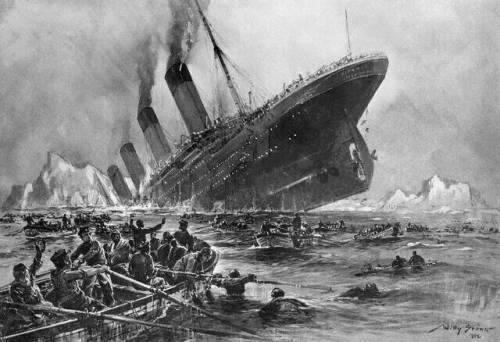 Leah Aks and Celiney Yasbeck shared many things in common. They both came to America as young immigrants and settled in the Norfolk area. They both were married in their mid-teens. And they both survived the sinking of the Titanic.
Leah Aks and Celiney Yasbeck shared many things in common. They both came to America as young immigrants and settled in the Norfolk area. They both were married in their mid-teens. And they both survived the sinking of the Titanic.
When the 100th anniversary of the sinking of the RMS Titanic was remembered in April, it was an international event.
���The Titanic is one of those stories that the public seems to latch onto. I think part of our fascination with it is because of all of the hype about the launch and it being unsinkable. Then on the maiden voyage to have it end as tragically as it did,��� said Armalita Holley with the Mariner���s Museum. She organized the museum���s Titanic Day in April.
While the last survivor of the disaster died in 1997, survivors��� families are still alive to remember their relatives and what they went through on the night April 14, 1912. Members of Aks��� and Yasbeck���s families also still live in the area near the ocean that nearly ended their lives before they began.
���When people find out that my great-grandmother was on the Titanic, they sometimes ask, ���Did she survive?��� I just look at them and say, ���If she didn���t, I wouldn���t be here,��� said Lisa Barr of Norfolk. She is also the great-granddaughter of Leah Aks.
For Barr and her siblings, the Titanic was more than just a film that made Leonardo diCaprio a star or a dramatic story, it is part of their family history.
Leah and Phillip Aks��
Leah Aks wasn���t supposed to be on the Titanic. Leah and her 10-month-old son, Phillip, whom everyone called ���Filly,��� had planned to sail for the U.S. on an earlier ship to be reunited with Sam Aks, Leah���s husband.
���Her mother convinced her to wait and travel on the Titanic because she believed it would be safer,��� said Gilbert Binder who married Aks��� granddaughter, Roberta Binder.
Aks, who was 18 at the time, and Filly shared a cabin with another third-class for the journey. She went to bed on April 14, but was awakened by an unusual noise. Though she didn���t know what it was, she trusted her intuition that something wasn���t right, according to Barr, grabbed up her son and headed for the deck.
She and Filly had only their nightclothes on as they stepped out of the cabin and into the passageway. The confusion was just beginning. The hall was dark with few lights on but Aks could feel cold water around her feet.
The water told her that there was a huge problem and she headed for the upper decks where the lifeboats were located. The closer she got to the stairs, though, the more crowded things the narrow hall got. The crew had closed and locked gates across the stairwells because there weren���t enough lifeboats for everyone and first- and second-class passengers had priority.
People began to yell and jostle each other. Some fights broke out. At some point, some of the men in the hall realized that a young mother was also trapped among them.
���She was literally lifted hand over head by the men who passed her forward and up and over the gate since she was small enough to fit through,��� Barr said.
On deck, things were just as confusing as below decks. People were pushing each other trying to get into life boats, music was playing, orders were being shouted and shots were fired. As one version of events goes, Aks found herself next to Madeline Astor, wife of multi-millionaire John Jacob Astor.
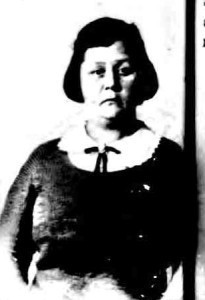
Leah Aks
Astor, who was pregnant herself, saw Aks and Filly. The wealthy woman removed her shawl and wrapped it around Filly.
���Your baby looks cold,��� Astor said. ���He needs this more than me.���
A short time later, a man who was upset because he wasn���t allowed onto a lifeboat, ran up to Aks, and said, ���I���ll show you women and children first!��� He then grabbed Filly and threw him overboard, according to historian Valery Bazarov in an article she wrote for the Hebrew Immigrant Aid Society.
Binder said Aks fainted when she saw her son apparently die. When she regained consciousness, she found herself pushed into a lifeboat that was about to be lowered.
Barely more than 700 people survived to be rescued. The other 1,514 people on board the Titanic went down with the ship. That Aks had beaten the odds didn���t matter to her because she believed Filly dead.
Once her lifeboat was rescued by the Carpathia, Aks lay down on a mattress in a state of shock. She remained this way for a couple days, rising only to use the bathroom or eat a little. Finally, a companion persuaded her to walk on deck for some fresh air. Aks did so and walked around in a daze until she heard a baby cry. She recognized the baby���s voice as Filly���s. Aks searched around frantically until she saw he son, still in Mrs. Astor���s shawl, being held by another woman.
Aks rushed forward, thanking the woman and telling her that the baby was her son. The woman, whose name was Argene del Carlo, wouldn���t give up the baby, though, and to make matters worse, she couldn���t speak English.
Aks sought out the help of Captain Arthur Roston of the Carpathia. Aks told him that she could prove that she was Filly���s mother. She showed the captain that she was still lactating while the other woman was not. Then she told Roston that she and Filly were Jewish and if he looked, he would see that Filly had been circumcised. The Italian woman was obviously Catholic since she wore a large gold cross around her neck and would not have had her son circumcised.
Convinced, Roston told del Carlo that she would have to give the baby up because he was Aks��� son.
���The Italian woman was really very nice,��� Binder said. ���Her husband hadn���t been allowed to get onto the lifeboats and she had been praying to God while the boat had been lowered. Then she looked up and saw this white thing falling toward her. She caught it and it turned out to be a baby. She took it as a sign from God that the baby was hers.���
Celiney Decker
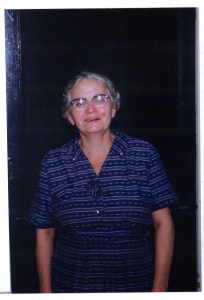
Celiney Decker in 1963.
In 1912, Celiney Decker was known as Selini Yasbeck, a 15-year-old Lebanese newlywed. She and her husband boarded the Titanic in France. They had been married less than two months. The Yasbecks were traveling with a group of friends to America where her husband, Antoni, had a business in Pennsylvania.
When the Titanic struck the iceberg during the night of April 14, impact woke Yasbeck. She and her husband dressed and went up on deck to see what was going on.
���Everyone seemed to shout and dance and the band played music,��� Yasbeck said in an interview in the Virginian-Pilot in 1951. ���People seemed to sing and laugh at first.���
People weren���t frightened that the ship had hit an iceberg because the Titanic was unsinkable. That festive atmosphere changed soon enough as the ship took on more water and the deck began flooding.
Yasbeck got into a boat. Her husband also tried to get on the boat, but he was forced away at gunpoint, according to Bob Decker, Yasbeck���s son who lives in Purcellville. This is because women and children were only being allowed on the life boats given how few spaces there were. As the life boat was lowered into the Atlantic Ocean, Yasbeck lost sight of her husband and would never regain it.
Even as her lifeboat floated away from the sinking ship, Yasbeck said she could still hear music playing mixed with the screams of people who knew they were going to die.
���She lost everything except the clothes on her back,��� Decker said.
Life Goes On
Sam Aks drove to New York to be reunited with his family when he learned they were among the survivors. This must have been a tough time, knowing the Titanic had sunk with hundreds of people on board without knowing who the survivors were.
���With the Marconi radio on board, people in the United States heard the distress signal before the Titanic even sank,��� Holley said.
Sam Aks was one of the lucky few who were able to reunite with family who had survived the sinking. According to Binder, ���Sam must have been very happy to see her (Leah) because my mother in law was born nine months later.���
Sara Carpathia Aks was born in St. Vincent de Paul Hospital in Norfolk on March 12, 1913. Leah had made herself a promise that she would name her next child after the ship that rescued her and Filly. Because she was a Titanic survivor, Aks was a local celebrity and the Catholic sisters were excited to have her as a patient, but they misunderstood what Aks told them Sara���s full name was. Instead of Carpathia, they wrote Sara Titanic Aks.
Sara went through life not knowing she was named after the doomed ship. She thought her middle name was Carpathia because that is what her mother had told her. It wasn���t until Sara applied for a passport in her fifties that she discovered her real middle name.
When she found out the truth, she was fit to be tied.
���If you put Titanic on my tombstone, I���ll haunt you for the rest of your life,��� Sara warned Binder.
He didn���t want to chance it. When his mother-in-law died in 2001, the family made sure to put ���Sara C. Weinraub��� on the grave marker.
While Aks didn���t talk about her experience on the Titanic much, her grandchildren made use of it.
���Her grandchildren all worked their way through high school writing about it,��� said Binder. ���Anything with Titanic on it got a good grade.���
As Filly Aks grew up, he seemed to enjoy his celebrity associated with the Titanic, according to Barr, although he had no memories of the events. This is probably why he could enjoy it.
Relatives drove to New York to get Yasbeck once they realized she had survived the sinking of the Titanic. She married Elias Decker, another Lebanese immigrant who had known her in Lebanon, in 1915, and they moved to Norfolk. The Deckers had 12 children together, nine of whom lived to adulthood.
���We heard about the Titanic, but we never thought much about it and she didn���t want to talk about it anyway,��� said Decker.�� ���The thing we all regretted was that we never asked more about it.���
One of the ways that Decker said his mother���s experience affected her was that she never went back on the water although they lived in Norfolk.
���We would go out fishing on a boat and she would worry to death until we came home,��� Decker said.
Though their cabins had been close to each other on the Titanic and they both lived in Norfolk only a few blocks from each other, Yasbeck and Aks didn���t meet until 1951.
Yasbeck died in 1966 at age 69. Aks passed away in 1967 at age 72. Filly died in 1991 at age 80. The Aks were buried in the family plot in the Forest Lawn Cemetery in Norfolk and the Yasbeck was buried in St. Mary���s Cemetery in Norfolk.
���From my point of view, we grew up knowing we were survivors. That���s what we learned my great-grandmother���s story,��� Barr said.

November 19, 2014
REVIEW: A Curious Man: The Strange and Brilliant Life of Robert “Believe It or Not!” Ripley��by Neal Thompson
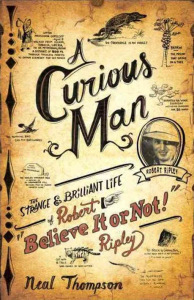 I remember picking up paperback books when I was a kid that were filled with Ripley���s Believe It or Not! cartoons. I loved them! Those little snippets of information peaked my interest about the world around me and instilled in me a fascination for the odd and unusual. This summer, one of the stops on my family���s Great Smokey Mountains vacation was to visit the Ripley���s Believe It or Not! Odditorium. I had hoped that it might spark curiosity in them as well.
I remember picking up paperback books when I was a kid that were filled with Ripley���s Believe It or Not! cartoons. I loved them! Those little snippets of information peaked my interest about the world around me and instilled in me a fascination for the odd and unusual. This summer, one of the stops on my family���s Great Smokey Mountains vacation was to visit the Ripley���s Believe It or Not! Odditorium. I had hoped that it might spark curiosity in them as well.
So when I saw, A Curious Man by Neal Thompson, my curiosity kicked in. Why hadn���t someone written about Robert Ripley before? I purchased the book and enjoyed it immensely.
It is the story of Robert Ripley���s journey from struggling newspaper cartoonist to cultural icon. He came from a poor family and was teased for his buckteeth and stutter. It is a true rags to riches story because Ripley also had talent, determination, and a strong work ethic.
A Curious Man also paints a picture of a talented man whose passion for travel and oddities gave way to a life of excess and then obsession.
Ripley conquered newspapers, books, radio, television, the speaking circuit and museum circuit. Even with the help of the staff that he eventually had, I am still amazed that he could do as much as he did and still travel for months at a time.
Along the way, readers get a good picture of life during an interesting time of American history���the Roaring 20s, the Great Depression, and WWII. They watch the rise and beginning decline of the newspaper industry.
I found the book easy to read and enjoy. I also liked the Ripley-style callouts of interesting factoids throughout the book that Thompson called ���Believe It.���
If I have one complaint about the book, it���s that it continued too long for me after Ripley���s death. The battling over the Ripley empire after his death held little interest for me.
A Curious Man made me start looking around for those old paperbacks again so that I could read more about the wonder of the world.


REVIEW: A Curious Man: The Strange and Brilliant Life of Robert “Believe It or Not!” Ripley by Neal Thompson
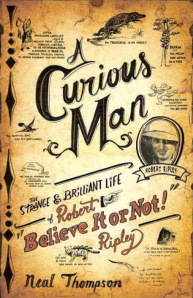 I remember picking up paperback books when I was a kid that were filled with Ripley’s Believe It or Not! cartoons. I loved them! Those little snippets of information peaked my interest about the world around me and instilled in me a fascination for the odd and unusual. This summer, one of the stops on my family’s Great Smokey Mountains vacation was to visit the Ripley’s Believe It or Not! Odditorium. I had hoped that it might spark curiosity in them as well.
I remember picking up paperback books when I was a kid that were filled with Ripley’s Believe It or Not! cartoons. I loved them! Those little snippets of information peaked my interest about the world around me and instilled in me a fascination for the odd and unusual. This summer, one of the stops on my family’s Great Smokey Mountains vacation was to visit the Ripley’s Believe It or Not! Odditorium. I had hoped that it might spark curiosity in them as well.
So when I saw, A Curious Man by Neal Thompson, my curiosity kicked in. Why hadn’t someone written about Robert Ripley before? I purchased the book and enjoyed it immensely.
It is the story of Robert Ripley’s journey from struggling newspaper cartoonist to cultural icon. He came from a poor family and was teased for his buckteeth and stutter. It is a true rags to riches story because Ripley also had talent, determination, and a strong work ethic.
A Curious Man also paints a picture of a talented man whose passion for travel and oddities gave way to a life of excess and then obsession.
Ripley conquered newspapers, books, radio, television, the speaking circuit and museum circuit. Even with the help of the staff that he eventually had, I am still amazed that he could do as much as he did and still travel for months at a time.
Along the way, readers get a good picture of life during an interesting time of American history—the Roaring 20s, the Great Depression, and WWII. They watch the rise and beginning decline of the newspaper industry.
I found the book easy to read and enjoy. I also liked the Ripley-style callouts of interesting factoids throughout the book that Thompson called “Believe It.”
If I have one complaint about the book, it’s that it continued too long for me after Ripley’s death. The battling over the Ripley empire after his death held little interest for me.
A Curious Man made me start looking around for those old paperbacks again so that I could read more about the wonder of the world.


November 11, 2014
Allegany County, Maryland, in the War of 1812
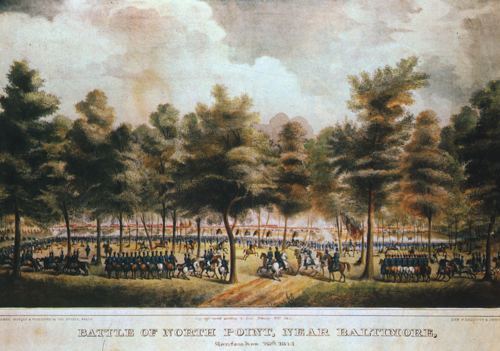 Some historians call the War of 1812 the second American Revolution. Less than a generation after America won her independence, she once again found herself battling Great Britain. It was a war that neither side wanted because both countries were still trying to recover from the original American Revolution.
Some historians call the War of 1812 the second American Revolution. Less than a generation after America won her independence, she once again found herself battling Great Britain. It was a war that neither side wanted because both countries were still trying to recover from the original American Revolution.
The British fought a defensive war in the early years of the War of 1812 because they were also fighting against Napoleon Bonaparte and the French army and navy in Europe. By 1814, Napoleon had been defeated and the British turned their attention more fully to ending the war with the United States with a victory. Up to this point, most of the fighting had been around the Canadian and U.S. border to the north. In the Mid-Atlantic, the British had started a blockade in 1813.
Preparing for War
In July 1814, President James Madison called on the states to supply militia to defend the young country. According to William Lowdermilk in A History of Cumberland, Maryland, “Maryland was required to furnish one Major-General, three Brigadier Generals; one Deputy Quartermaster-General, one Assistant Adjutant-General, and six regiments, to consist of 600 artillerists, and 5,400 infantry.”
However, war is a political question as well as a military one, and Maryland was split on the need to go to war. The Federalists called themselves the “Friends of Peace.” Their position was that the U.S. should fight only to defend its borders and not seek to take territory from Canada, which had been happening on the northern front of the war. The Democrats were called “War Hawks” and fully supported not only a defensive war but an offensive one.
In the fall elections of 1814, the Democrats nominated Thomas Cresap, Thomas Greenwell, Benjamin Tomlinson and Upton Bruce to the state legislature. It was the Federalists who swept the election, though. Jesse Tomlinson, William McMahon, William Hilleary and Jacob Lantz were elected and sent to Annapolis to represent the county.
Around that time, the county also moved towards filling its portion of the state’s militia quota and there was “a considerable degree of enthusiasm manifested,” according to Lowdermilk.
While county residents hadn’t been engaged in any military conflicts since the Revolutionary War, volunteer groups had been meeting to drill, shoot targets and discuss fighting techniques. Lowdermilk wrote that some of the volunteers had served in the Revolutionary War as members of the Maryland Line.
Maryland soldiers had distinguished themselves for their bravery and ability during the Revolutionary War. They were so dependable that it is said George Washington called the Maryland regiments his “Old Line,” which is where one of Maryland’s nicknames as “The Old Line State” comes from, according to the Maryland Archives.
Answering the Call
In the fall of 1814, two companies were formed in Allegany County that totaled 227 fighting men. Captain Thomas Blair formed one company primarily with men from Cumberland. Captain William McLaughlin formed his company with men outside of the city.
Lowdermilk noted of Blair’s company, “The Company formed in Cumberland was made up of excellent material, the organization having been effected some months before.”
Once formed, the men marched to Baltimore in August where they became part of the First Regiment of Maryland Militia, under General Samuel Smith and Colonel John Ragan. They spend most of their time at Camp Diehl wondering if they would see any fighting.
Seeing Action
On September 12, a British fleet of more than 30 warships and transports sailed up the Chesapeake Bay and landed 5,000 troops on the North Point peninsula. The American militia of 3,000 men, including the soldiers from Allegany County, met the British troops at Godly Wood, eight miles north of the British landing point.
The two sides exchanged musket and artillery fire for about an hour before the British troops’ superior size forced the Americans back toward Baltimore. However, the Americans inflicted heavy casualties on the British, including mortally wounding the British commander Maj. General Robert Ross.
With the loss of the lionized Major-General Robert Ross to tree-hidden American sharpshooters, the British advance toward the city slowed whilst the powerful fleet lay useless against Fort McHenry because of the tremendous amount of blockage which had been dropped into the channel,” according to the General Society of the War of 1812 web site.
The bombardment of Fort McHenry, which led to Francis Scott Key to write the words to “The Star-Spangled Banner,” began the following day.
Celebrating
Back in Allegany County, news reached the residents of the American victory on Lake Champlain between New York, Vermont and Quebec and the people celebrated. “Processions paraded the streets, singing and shouting, and the entire population took part in the celebration,” Lowdermilk wrote.
The county’s soldiers were mustered out on October 13, after which they returned to the county and were disbanded in early November.




